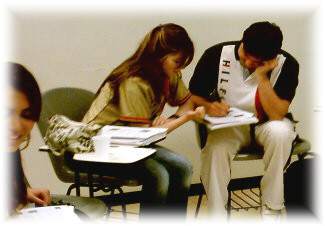
You’re teaching EAP? Forget most of what you know about grammar (kind of!)
– Adam Simpson
The name Daniel Horowitz may not be that familiar to you, nor to many in the world of English language teaching. Nevertheless, this man’s writings in the 1980s have had as profound an effect on my teaching as any other individual. Part of the reason he is not well known is that he was sadly taken from us before his time, but also because he was not frightened of rattling the establishment and speaking out against what he knew to be wrong, or at very least ineffective in language teaching. I consider myself fortunate, therefore, to find myself in a working environment where his ideas have come to life.
As the title of this post suggests, Horowitz had certain ideas on what constituted ‘academic English’ and indeed what that meant in terms of grammatical focus. My aim today is to show you how logical and practicable Horowitz’s suggestions are, and yet how they probably aren’t being implemented in a lot of supposedly EAP courses. I feel that it is pertinent at this point to look at the main functional categories that Horowitz suggested comprise academic discourse, and the specific functional objectives that each and every EAP course therefore should aim to teach. If you teach EAP, look at the program you’re involved with and ask questions if you don’t see these things being covered.
Now, let’s look at each of these functional categories and think about what they mean in terms of grammar. Please bear in mind that this is just a brief overview:
Displaying familiarity with a concept
So, what do you need to do to ‘display familiarity’ with something? This might mean defining, exemplifying or giving a physical description. At lower levels, this might mean using the simple present tense and focusing on the use of articles. As learners progress, they might be exposed to defining and non-defining relative clauses.
Expressing similarities and differences
This is as simple as the title suggests: to do this you need to be describe and account for differences, or compare and classify concepts. At lower levels, this might mean using comparative and superlative adjectives, or comparison of nouns (more, less, fewer). As learners progress, they might be required to use adverbials of concession (although, despite (the fact that), in spite of (the fact that), nevertheless), for instance.
Expressing cause and effect relationships
So, how might we express cause and effect relationships? This might mean having to identify historical causes and contributory factors, or indicate goals and express results. At lower levels, this might mean using specific verbs (is caused by, result from, contribute to). As learners progress, they might start to learn other expressions (as a result of, because of, as, since, because, due to therefore, thus, so, as a consequence of, for this reason, the more … the more, owing to) and noun complement clauses with ‘the fact + that-clause’ (e.g. ‘The fact that Prozac is so powerful undermines the power of psychotherapy’).
Displaying familiarity with a process
So, what do you need to do to ‘display familiarity’ with a process? This requires the learner to be able to describe a scientific process, or narrate a historical process. At lower levels, learners might encounter the passive voice (made (of), given, taken, used (for), known (as), defined (as), related (to), associated (with), composed (of), linked (to/with), based (on)) and sequencing meta-discourse (first (of all), next, finally, at the same time, the first/next/final step/stage, after/before that). As learners progress, they might be exposed to other structures such as ‘Having’ + participle (-ed) phrase + clause (e.g. Having completed the research, we can now determine…).
Displaying familiarity with argumentation
So, how do we ‘display familiarity’ with argumentation? This might mean emphasizing a point, evaluating ideas, or paraphrasing and summarizing an argument. At lower levels, this can involve using expressing obligation with modal verbs (present and future: have to, don’t have to, must, should, allowed to, need to). At higher levels learners might be exposed to structures such as noun complement clauses (N + that-clause + evaluation) with head nouns (idea, assumption, assertion, realization, discovery, proposition, recognition, evidence, proof, sign, indication, (e.g. the assumption that the population was evenly distributed is not a good one here)).
Using an academic style
What does it mean to use an academic style? This might require being concise, precise and objective. At lower levels, this might mean avoiding repetition through the use of synonyms, pronouns (personal, possessive and reflexive). As learners move on in their studies, they might be exposed to participle clauses including reduced relative clauses, for instance.
Is it really so different?
Hopefully, none of the examples I’ve given will appear to be dramatically different from what you might traditionally consider to be ‘grammar’. Therein lies the problem with academic grammar: it is both very similar to what we might teach in a general English course and yet with sometimes drastic differences in emphasis.
If you’re familiar with the progression we see in many course books, you might have noticed that I didn’t mention the present continuous or the present perfect in my examples. That’s because they are noticeably less important to the academic world than they are in everyday life. I mention these as they are particular stalwarts of many a grammar syllabus, and exactly the kind of things that Horowitz would have told you to downplay in your teaching (and which consequently made his suggestions seem so difficult to accept).
Your biggest challenge, and one I hope you’ll take up if you teach EAP, is to think about what your learners really need and don’t be afraid to focus more on things such as the passive voice and simple tenses and less on the present continuous or the present perfect. While this is merely a brief introduction to academic grammar, I’d be happy to discuss this in more detail with anyone interested.
Suggested reading
The Contribution of Daniel Horowitz by Ann M. Johns – JALT Publications (available by clicking here jalt-publications.org/files/pdf-article/jj-12.1-art2.pdf)
Connect with Ann, Adam, Alexandra, Arzu, Rose, Miguel, and other iTDi Associates, Mentors, and Faculty by joining iTDi Community. Sign Up For A Free iTDi Account to create your profile and get immediate access to our social forums and trial lessons from our English For Teachers and Teacher Development courses.







